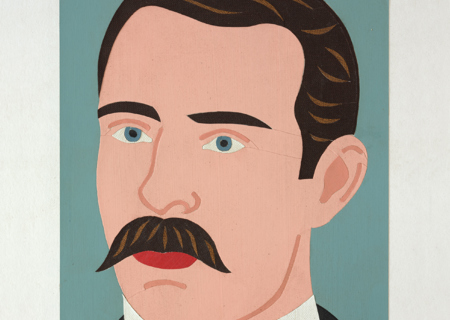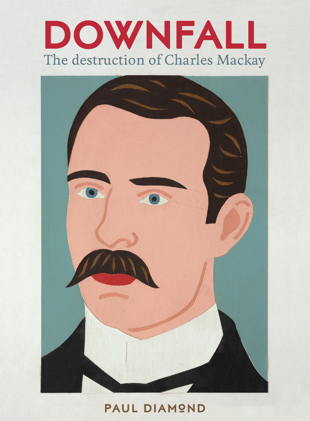Will Hansen has reviewed Downfall: The Destruction of Charles Mackay by Paul Diamond:
'THE ‘WANGANUI SENSATION’ is a major event in New Zealand’s queer history. No newspaper was silent when Whanganui mayor Charles Mackay shot soldier-poet D’Arcy Cresswell in 1920, after Cresswell had attempted to blackmail Mackay into giving up his mayoralty by threatening to make public his sexuality. In Paul Diamond’s insightful new account, we are finally treated to an in-depth examination as he leads readers on a journey spanning from Whanganui to Berlin and back again, unveiling the intricate worlds homosexual men navigated and the forces that bore down so strongly on their lives. While Diamond is careful to respect Mackay and Cresswell’s autonomy, underscoring that we can never really know what homosexuality meant to them, that homosexuality nonetheless played an unequivocally significant role in their lives is at the heart of Diamond’s book.
Downfall joins a growing cadre of works about historic queer New Zealanders, including Julie Glamuzina’s Spies and Lies: The Mysterious Dr Dannevill (2021), Brent Coutts’ Crossing the Lines: The Story of Three Homosexual New Zealand Soldiers in World War II (2020), Joanne Drayton’s Hudson & Halls: The Food of Love (2018), and Chris Brickell’s edited collection, James Courage Diaries (2021). These books, like Downfall, reclaim a place for queer people in New Zealand’s broader national histories. Mackay’s ‘destruction’ takes centre stage – Diamond provides an in-depth examination from the days prior to the shooting through to the trial – but we also gain insights through Mackay and Cresswell into Whanganui’s local politics, life in New Zealand’s prisons, the Esperanto movement, the fledgling advertising industry, the New Zealand literary scene, and more. Even Mackay’s death – murdered while working as a journalist to investigate the 1929 Blutmai riots, a significant event in the fall of the Weimar Republic and rise of the Nazi Party – holds tremendous historic importance.
Downfall is also a book about how history travels. Diamond explores the concerted attempts made to erase Mackay’s story, and how it has continued to find its way into the hands of historians, writers, and artists. A major strength of Downfall is Diamond’s deft management of this history’s unknowables. How did Cresswell know Mackay was homosexual? Why did Cresswell decide to blackmail Mackay when he himself was homosexual? How did Mackay and Cresswell each make sense of their own homosexuality? Like Brickell in his groundbreaking study Mates & Lovers: A History of Gay New Zealand, Diamond is careful to honour historic understandings, while also not shying away from revealing how this history connects with a longer lineage of queerness.
Above all, Downfall is about queer life. No aspect of the story is untouched by queerness. State policing and social condemnation of queerness created so much of the violence in Mackay’s life. Mackay’s story is an interesting insight into the growing medicalization of homosexuality in New Zealand that began to challenge religious views of homosexuality as a sin. Mackay sought treatment for his homosexuality in 1914, and Mackay’s lawyer attempted to reduce his sentence by arguing he suffered from a ‘homo-sexual monomania’, a sickness requiring treatment instead of incarceration (p.42). Reactionary views held their own, however; in an editorial published in the Patea & Waverley Press, Mackay was described as a ‘cancerous growth’ and an ‘evil’ in Whanganui’s midst (p.102).
Nonetheless, after his time in prison – including a brief stint in New Plymouth prison, which was the designated prison for homosexual men from 1917 to 1952 – Mackay forged a re-invention of himself in London and Berlin. These interwar cities are rekindled with Diamond conjuring forth their queer pasts. In London, Mackay lived near the infamous cruising grounds of St James Park and worked in Adelphi, ‘the centre of London’s queer life’ (p.150). Mackay chose Schöneberg as his Berlin home, moving himself into the ‘midst of the world’s most vibrant gay culture’, living across the road from gay bars in the city that was the centre of the homosexual emancipation movement (p.175). Diamond’s account of how the extensive homosexual underworlds of these cities must have looked to the smalltown New Zealand man is fascinating.
Mackay may have reclaimed a life for himself in Europe, but he was undoubtedly scarred by the shooting and its consequences. Exiled, his illustrious political and legal career in shambles, subject to such an intense scrubbing from history as to have even his name scratched off the foundation stone of the Sarjeant Gallery, despite being a ‘driving force in its construction’ (p.27). What would he think of Diamond’s account? Through Diamond’s words Mackay comes alive as ‘irrepressible and courageous’ (p.279). Although his story held great tragedy, Diamond ensures that no reader could walk away from Downfall viewing queer sexuality in Mackay’s lifetime through only a negative lens. Mackay’s life was characterized by ‘resistance – of refusing to settle, of continually challenging norms, of being knocked down and getting up again’ (p.279).
Men like Mackay and Cresswell faced challenges because of their homosexuality, but nonetheless made lives for themselves; they found joy, sex, companionship, and purpose. Diamond is determined that the queer complexities of Mackay’s history will no longer be overshadowed, making Downfall a wonderful addition to New Zealand’s bold and growing field of queer history.'


